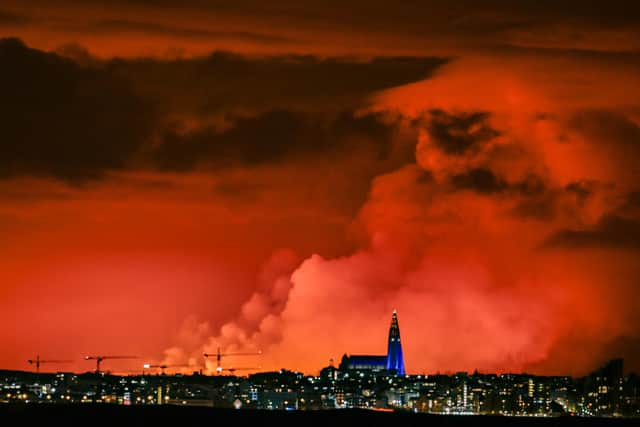Iceland defences under siege as volcano erupts for fourth time in months
Lava from a volcanic eruption in Iceland is continuing to flow towards defences around the town of Grindavik, which have so far held the molten rock back from the evacuated community.
A state of emergency has been declared in southern Iceland in the wake of the eruption.
Advertisement
Hide AdAdvertisement
Hide AdHowever, scientists said on Sunday the eruption appeared to be weakening and would probably peter out within hours.


A volcanic system on the Reykjanes Peninsula in the country's south-west erupted late on Saturday for the fourth time in three months, sending orange jets of lava into the night sky.
Iceland's Meteorological Office said the eruption opened a fissure in the earth about two miles long between the mountains of Stora-Skogfell and Hagafell.
The body said on Sunday that lava was flowing south and south-east at about 0.6mph, and might reach the sea.
Defensive barriers have been built to stop it inundating the main road along the peninsula's southern coast.
Hundreds of people were evacuated from the Blue Lagoon thermal spa, one of Iceland's top tourist attractions, when the eruption began, national broadcaster RUV said.
No flight disruption was reported at nearby Keflavik, Iceland's main airport.
Einar Bessi Gestsson, a natural disaster expert at the Norwegian Meteorological Agency, told Iceland's public broadcaster RUV that small explosions could occur if the lava made contact with sea water.
Advertisement
Hide AdAdvertisement
Hide AdThe eruption site is a few miles north-east of Grindavik, a coastal town of 3,800 people about 30 miles south-west of the capital, Reykjavik.
The town was evacuated before the initial eruption on December 18, and a second eruption that began on January 14 sent lava towards the town.
Defensive walls that had been bolstered after the first eruption stopped some of the flow, but several buildings were consumed by the lava.
Both eruptions lasted only a matter of days. A third eruption began on February 8 and ended within hours, but not before a river of lava engulfed a pipeline, cutting off heat and hot water to thousands of people.
Iceland, which sits above a volcanic hotspot in the North Atlantic, sees regular eruptions and is highly experienced at dealing with them.
The country has 33 active volcano systems and is positioned over the Mid-Atlantic Ridge a boundary between two of the largest tectonic plates on the planet.
There have been seven eruptions in Iceland since 2021, amid forecasts by scientists that a new volcanic era could last decades or even centuries
RUV quoted geophysicist Magnus Tumi Gudmundsson as saying the latest eruption was the most powerful so far.
Advertisement
Hide AdAdvertisement
Hide AdThe most disruptive in recent times was the 2010 eruption of the Eyjafjallajokull volcano, which spewed huge clouds of ash into the atmosphere and led to widespread airspace closures over Europe.
No confirmed deaths have been reported from any of the recent eruptions, but a workman was declared missing after falling into a fissure opened by the volcano.
Comments
Want to join the conversation? Please or to comment on this article.